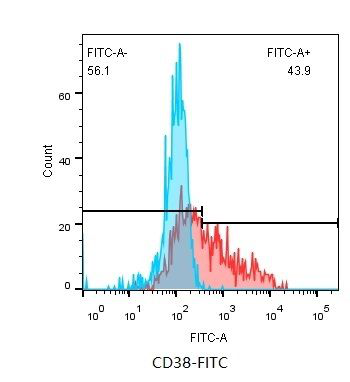产品货号 : mlR30084
英文名称 : human CD55-PE
中文名称 : PE标记小鼠抗人CD55单克隆抗体
别 名 : CD 55; CD55; CD55 antigen; CD55 Cromer blood group system; CD55 molecule; CD55 molecule, decay accelerating factor for complement (Cromer blood group); Cd55a; Complement decay accelerating factor; Complement decay-accelerating factor; Complement decay-accelerating factor, GPI-anchored; CR; CROM; Cromer Blood Group antigen; Cromer blood group system; DAF; Daf-GPI; DAF_HUMAN; Daf1; Dcay accelerating factor for complement (CD55, Cromer blood group system); Decay accelarating factor 1, isoform CRA_a; Decay accelerating factor (GPI-form); Decay Accelerating Factor for Complement; Decay accelerating factor GPI-form; Decay accelerating factor soluble-form; GPI-DAF; TC.
研究领域 : 免疫学 细胞表面分子 细胞类型标志物 淋巴细胞 t-淋巴细胞
抗体来源 : Mouse
克隆类型 : Monoclonal
克 隆 号 : HI55a
交叉反应 : Human,
产品应用 : Flow-Cyt=20ul/Test
not yet tested in other applications.
optimal dilutions/concentrations should be determined by the end user.
分 子 量 : 35kDa
细胞定位 : 细胞膜 分泌型蛋白
性 状 : Liquid
亚 型 : IgG2a
纯化方法 : affinity purified by Protein G
储 存 液 : 0.01M TBS(pH7.4) with 1% BSA, 0.03% Proclin300 and 50% Glycerol.
保存条件 : Store at -20 °C for one year. Avoid repeated freeze/thaw cycles. The lyophilized antibody is stable at room temperature for at least one month and for greater than a year when kept at -20°C. When reconstituted in sterile pH 7.4 0.01M PBS or diluent of antibody the antibody is stable for at least two weeks at 2-4 °C.
PubMed : PubMed
产品介绍 : This gene encodes a protein involved in the regulation of the complement cascade. The encoded glycoprotein is also known as the decay-accelerating factor (DAF); binding of DAF to complement proteins accelerates their decay, disrupting the cascade and preventing damage to host cells. Antigens present on the DAF glycoprotein constitute the Cromer blood group system (CROM). Two alternatively spliced transcripts encoding different proteins have been identified. The predominant transcript encodes a membrane-bound protein expressed on cells exposed to plasma component proteins but an alternatively spliced transcript produces a soluble protein present at much lower levels. Additional, alternatively spliced transcript variants have been described, but their biological validity has not been determined.
Function:
This protein recognizes C4b and C3b fragments that condense with cell-surface hydroxyl or amino groups when nascent C4b and C3b are locally generated during C4 and c3 activation. Interaction of daf with cell-associated C4b and C3b polypeptides interferes with their ability to catalyze the conversion of C2 and factor B to enzymatically active C2a and Bb and thereby prevents the formation of C4b2a and C3bBb, the amplification convertases of the complement cascade.
Subunit:
Monomer (major form) and non-disulfide-linked, covalent homodimer (minor form). Binds to coxsackievirus A21, coxsackieviruses B1, B3 and B5, human enterovirus 70, human echoviruses 6, 7, 11, 12, 20 and 21 capsid proteins and acts as a receptor for these viruses.
Subcellular Location:
Isoform 1: Cell membrane; Single-pass type I membrane protein.
Isoform 2: Cell membrane; Lipid-anchor, GPI-anchor.
Tissue Specificity:
Expressed on the plasma membranes of all cell types that are in intimate contact with plasma complement proteins. It is also found on the surfaces of epithelial cells lining extracellular compartments, and variants of the molecule are present in body fluids and in extracellular matrix.
Post-translational modifications:
The Ser/Thr-rich domain is heavily O-glycosylated.
Similarity:
Belongs to the receptors of complement activation (RCA) family.
Contains 4 Sushi (CCP/SCR) domains.
SWISS:
P08174
Gene ID:
1604
Important Note:
This product as supplied is intended for research use only, not for use in human, therapeutic or diagnostic applications.
产品图片












